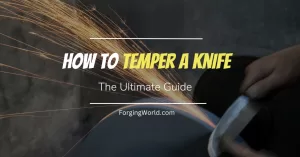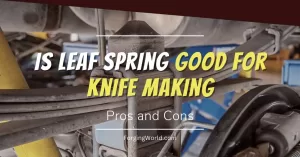Everyone had to start somewhere. No reasonable human being can expect to become an expert in a particular field after just a couple of days. The same thing applies to knifemaking. There is a big chance of failing numerous times of making a good knife, especially in the beginning phases.
Remember, making mistakes as a beginner knifemaker is completely normal. You will mostly learn by trial and error. However, there is one big enemy which can hold you back from developing your skills. That is ego. The ego is the single biggest enemy of improvement. Don’t let it control you.
7 Knife-Making Mistakes
- Starting with complex projects
- Using mystery steel
- Thinking there is only one “super steel”
- Over-buying the equipment
- Not learning enough about metallurgy
- Not wearing safety equipment
- Forcing the forging method
Before we continue, I would like to make clear here that I am not making fun of anybody. If I would be doing that, I would also make fun of myself since I made the majority of these mistakes myself.
This article is all about how to avoid making these mistakes and advance in improving yourself as a knifemaker as easily and quickly as possible. Nobody is making fun of anybody.
Ok, now we can finally dive in.
1: Starting with Complex Projects
This is by far one of the most well-known mistakes in knifemaking. You know, a lot of jump into this craft trying to make something extremely difficult blade. The usual choice of these folks is some kind of sword. But not just any kind of sword, they want to make some rare piece of the blade that will sell for a few thousand bucks.
Unfortunately, it doesn’t work that way. At first, you may ask yourself-How can anybody expect to think like that? The answer lies in the problem of our ego. As I have said earlier, the ego is the biggest enemy of improvement. Don’t let it talk you into thinking you are some special knife maker who doesn’t require experience for making advanced projects. Embrace it, you are a beginner and you should treat yourself that way. Of course, I don’t want you to aim low. Far from that actually, but you have to understand that anything great takes time.
Let me tell you my story. When I was just starting out, one of my first projects was forging a katana. Yes, you read that right. Imagine someone with no experience, watching the youtube tutorial on how to forge a katana sword. I mean, you can already guess how that went. It was a complete failure. However, an important lesson was learned.
How to avoid it
The first thing you want to do is to remove that voice inside your head telling you you can immediately start big. The desire for progress should be something you desire the most. Once you made this stuff very clear in your head, you can start working on some simple projects, something like a basic survival knife. After you make a couple of them, you can move into something slightly more complicated.
The key is to take steps gradually, not jumping straight into advanced projects. I would also like to point out here that the stock removal method is more beginner-friendly than the forging technique, but more on that later on.
2: Using Mystery Steel
Mystery steel refers to any material you don’t know its chemical composition and working qualities. The fact is, every single steel is different and you have to treat them differently or you won’t get the results you are looking for. It is that simple. The reason why mystery steel is commonly used by beginners is that it is readily available and cheap.
One of the most popular mystery steel is rebar. Chances are you have some of it in your garage. Unfortunately, you don’t know anything about it. You don’t know how much carbon it has and whether it is hardenable or not. As you can see, making a knife out of mystery steel is a huge risk.
However, if using mystery steel is for practice purposes only then fine, go for it. But, if you are planning to make a serious knife out of it, be prepared for the worst scenario.
How to avoid it
The answer is very simple. Don’t use it. Instead, buy something like a 1080 or 1075 steel high-carbon steel. Both are very beginner-friendly and don’t require any special heat treatment. With proper steel, you drastically increase the chances of making good-quality steel. So, if you don’t want to risk your time, use high-carbon steel.
3: Relying on One Type of Steel
If you have ever been to various forums, you probably realized that for some people, there is only “the one” forging steel for knife making. In their opinion, all others are not worth it. Be very careful not to fall into this trap of thinking. Most of these people are older ones who managed to work only with one type of steel. There is no single best steel for knife making. It all depends on the intended purpose and type of knife.
How to avoid it
Again, very simple. Learn about the basic types of steel for knife making. See which ones are easily available. Decide which type of knife you want and make research about which steel would be good for that knife. However, in the end, it all comes to heat treatment. Even if you picked the perfect steel, if it is not properly heat treated, the knife will be useless. To make a simple knife, most of the high-carbon steels will be just fine.
4: Over Spending on Tools and Equipment
When entering the world of any craft, people tend to buy both stuff they actually need and stuff they don’t. The same scenario is in knifemaking. Guy gets interested in knifemaking, and a few days later he is making space for a $2000 belt grinder he ordered the day before. Classic story. Don’t be that guy. People like this usually think that advanced equipment will make them better knife makers. Just like soccer shoes don’t make a good soccer player the same thing is with a knife maker.
An expensive belt grinder won’t make you a better knifemaker. I mean, yes, the equipment does help, but at the end of the day, it is your eye, artistic sensibility, patience, and diligence that matters. You would be shocked by what you can do with only a set of basic tools.
How to avoid it
To start with knifemaking, only buy a basic set of tools. With just a couple of hand tools, you are able to make a knife. Don’t spend thousands of dollars on expensive equipment.
5: Lack of Basic Metallurgy Knowledge
It is actually very funny when you think about the fact that most beginner knifemakers don’t know the fundamentals of the mechanical properties of steel. It’s the same as if the chef doesn’t know what he’s cooking. It is shocking I know. I could understand people in the past when there wasn’t a lot of information. But today you don’t have any excuse not to be well-equipped with knowledge.
Keep in mind that even if you managed to make a couple of knives without knowing too much about metallurgy, you will need to learn it sooner or later. I mean, it is impossible to heat-treat the knife without knowing what each phase does to steel.
How to avoid it
Learn about the most common alloying elements and their effects. Read books about metallurgy, watch youtube videos, etc.
6: Not Wearing Proper Safety Equipment
This mistake is by far the most dangerous one for a very good reason. For example, not wearing safety glasses can make you completely blind, and not wearing ear protection can drastically impair your hearing. The list goes on and on. Please don’t let your ego pulls you on this one. Don’t think you are the “badass” because you don’t wear any safety equipment. If you are not taking necessary precautions, you are not badass but a big fool.
How to avoid it
The number one habit you have to create is putting on your safety glasses as soon as you entered the shop. During the work at the anvil, make sure to wear ear protection, especially if your anvil produces a ringing noise. To learn more about the safety equipment and safety rules make sure to check:
7: Forging by Force
I know you saw Forged in Fire and now you want to do the same thing. But wait a minute, you are only a beginner. You don’t have decades of forging experience as these guys do. Trust me, I completely understand that burning desire to immediately go into the shop and start hammering hot metal. Forging requires much more knowledge and experience.
How to avoid it
However, for someone who just started knife making, I would strongly recommend using the stock removal method instead of forging. With stock removal, you actually do a lot of grinding until you achieved the desired shape of the knife. This is a good way of gaining a lot of experience in knife making. The stock removal method is also much faster, meaning you can do a lot more work in less time.


